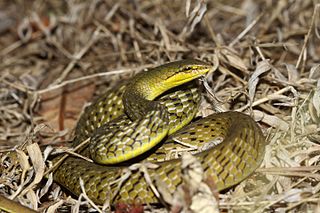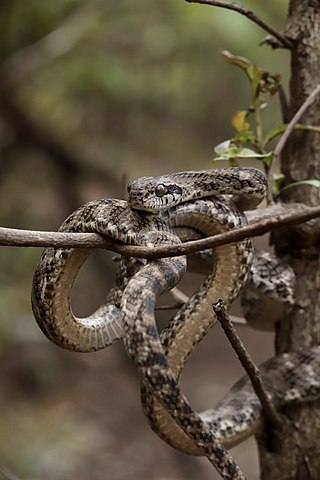
Ahaetulla perroteti, known commonly as the bronze-headed vine snake, Perrotet's vine snake, or the Western Ghats bronzeback, is a species of mildly venomous, rear-fanged snake in the family Colubridae. The species is endemic to the Western Ghats in South India.

Amphiesma monticola, also known as the Wynad keelback, is a harmless colubrid snake species endemic to the Western Ghats of India, where it has been recorded in the Kodagu and Wayanad regions.
The Assam keelback, commonly known as Peal's keelback, is a species of snake in the subfamily Natricinae of the family Colubridae. The species is endemic to Northeast India. It has recently been rediscovered after 129 years in Arunachal Pradesh.

The Himalayan keelback is a species of grass snake in the family Colubridae. The species is endemic to South Asia.
Blythia reticulata, commonly known as Blyth's reticulate snake, Blyth's reticulated snake, or the iridescent snake, is a species of snake in the subfamily Natricinae of the family Colubridae of the superfamily Colubroidea. The species is endemic to Asia.

Boiga forsteni, also known commonly as Forsten's cat snake, is a species of mildly venomous rear-fanged snake in the family Colubridae. The species is endemic to South Asia.

The collared reed snake is a species of colubrid snake found in Asia. In Japan, it is also called Miyara's collared snake.

Platyceps gracilis, commonly known as the graceful racer or slender racer, is a species of snake endemic to West India.

The white-banded wolf snake, also known as the northern large-toothed snake, is a species of colubrid snake found in Asia.

Lycodon aulicus, commonly known as the Indian wolf snake or common wolf snake, is a species of nonvenomous snake found in South Asia and Southeast Asia. Early naturalists have suggested its resemblance to the venomous common krait as an instance of Batesian mimicry.

Lycodon jara, commonly known as the twin-spotted wolf snake, is a species of colubrid snake. It is endemic to Asia.

The banded kukri snake, russet kukri snake, or common kukri snake,, is a species of nonvenomous colubrid found mainly in South Asia.

Oligodon cinereus, the ashy kukri snake or Günther's kukri snake, is a species of snake in the family Colubridae.

The painted keelback is a species of colubrid snake found in Pakistan, Nepal, Bangladesh, and India. This snake is also called the dark-bellied marsh snake.

The checkered keelback, also known commonly as the Asiatic water snake, is a common species in the subfamily Natricinae of the family Colubridae. The species is endemic to Asia. It is non-venomous.

Sibynophis subpunctatus, commonly known as Duméril's black-headed snake or Jerdon's many-toothed snake, is a species of nonvenomous colubrid snake endemic to Bangladesh, India, Sri Lanka, and Nepal.

Psammophis leithii, commonly called Leith's sand snake, the Pakistani ribbon snake, and the Pakistan sand racer, is a species of rear-fanged, mildly venomous snake in the family Psammophiidae. The species is native to South Asia. It is harmless to humans.

Lytorhynchus paradoxus, commonly known as the Sindh awl-headed snake and the Sind longnose sand snake, is a species of snake in the family Colubridae. The species is native to the desert areas of Pakistan and India (Rajasthan).

Sibynophis collaris, commonly known as the common many-toothed snake,Betty's many toothed snake or the collared black-headed snake, is a species of colubrid snake endemic to South and East Asia.
Uropeltis rubrolineata is a species of nonvenomous shieldtail snake in the family Uropeltidae. The species is endemic to southern India. There are no subspecies that are recognized as being valid.


















